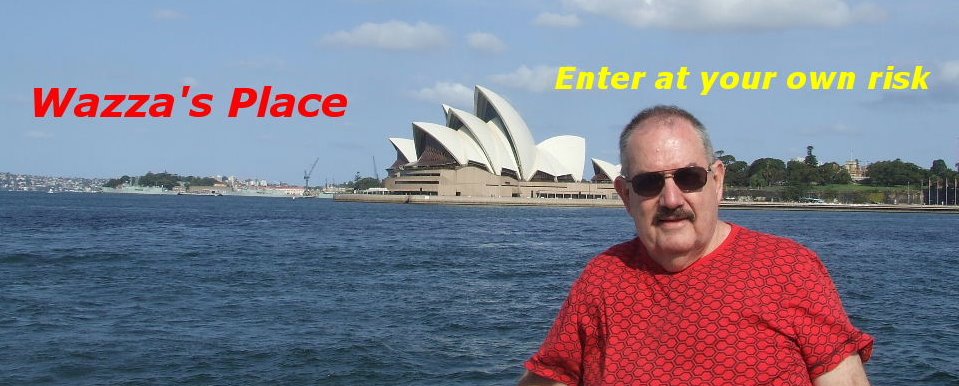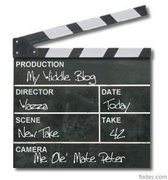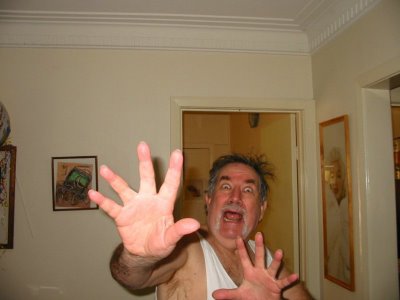Brisbane to Perth with Holtie Part 8
From Carnarvon we drove 480km south to the turnoff
to Kalbarri. Another 66km we arrived at one of the
prettiest tourist towns, Kalbarri where we were going
to stay for the next 2 days.
Kalbarri is a Western Australian resort town, which is fast
becoming a popular destination with overseas and Australian
visitors. The history of the area extends back to 1629, before
being wrecked on the nearby offshore Abrolhos Islands, the
Dutch East India trading ship Batavia, put two mutinous crew
ashore at Wittecarra Creek near Bluff Point, south of Kalbarri.
They are believed to be the first permanent European settlers
to this country.

It was overcast when we arrived at Kalbarri.
In 1712 another
became the first recorded of the many boats wrecked on the
rugged cliffs of the Murchison area. The site of the 1712
calamity is commemorated by the naming of the Zuytdorp
Cliffs north of the Murchison rivermouth at Kalbarri.
Some of the ruggard coastline around Kalbarri.
Kalbarri is believed to be named after a prominent
member of the Aboriginal people known as the Nanda
who lived in the area. It is also similar to the name of
an edible seed "Kalbar" which is commonly known as
the woody pear tree. The Aboriginal name for the area
of Kalbarri has been recorded as "Wurdimarlu".
In the Dreaming, the Rainbow Serpent wandered through
the land to wake all ancestors who still slept below the
surface. She came from inland and headed towards the sea,
leaving a track which is today known as the
We arrived in the afternoon and after setting up camp
we decided to go down to the local fish and chip shop
for dinner. The seaside was right near where we were
enjoying our meal and we witnessed one of the best
sunsets I have ever seen.
The start of a magnificent sunset looking east.
Kalbarri is located at the mouth of the Murchison River,
with the back drop of the Indian Ocean and the Zuytdorp
cliffs, famous for many a shipwreck. Kalbarri became a
town in the early 1950’s. Initially being a quiet fishing town,
Kalbarri has grown to a population of around 2000 with
many people in the crayfishing and tourisms industry.
If you're a seafood lover the crayfish is excellent eating.
During holiday seasons, the population can reach 6000
visitors with 200,000 people visiting Kalbarri every year.
 The tail end of the sunset looking west.
The tail end of the sunset looking west.
The next day we drove a few miles out of town to visit the
Rainbow Jungle. Established in 1986, with around 350 birds
including 50 species of Australian parrots and cockatoos,
Rainbow Jungle is a world leader in the breeding of
endangered species of parrots, cockatoos and exotic birds,
with the largest parrots in free-flight walk-in area in
Part of the landscaping and walkway inside the Rainbow Jungle.
Australian King Parrot
.....................................................Rainbow Lorikeet
It took 300 tonnes of tumblagooda sandstone to build
and is beautifully planted and landscaped and is well
worth the visit when in Kalbarri.
The Australian Parrot Breeding Centre, Rainbow Jungle has
been voted the number one attraction for excellence in the
Kalbarri area. It has won the Telstra award for tourism for
the whole of the Mid West of
twice been featured on The Great Outdoors TV program.
It has also been the focus of numerous magazines and
media articles both in
The bird on the left is a Princess
Parrot and after taking this picture
I swapped to my video camera.
The sight of my camera fairly close
to the bird must of made the parrot
interested in my camera and it
slowly edged closer to me, stopped,
looked around, moved closer,
stopped and finally when it was
close enough reached forward and
pecked the rubber lens cover of the
camera, which is all caught on film.
We spent a couple of hours at
Rainbow Jungle before driving off
to see some more sights of Kalabarri.
A Princess Parrot and a Australian King Parrot.
The next morning we were on the road early and 165km
later we drove into Geraldton. Here we viewed the very
moving memorial to the sinking of the HMAS
during World War II.
Geraldton has a population of 30,000, making it the fifth
largest city in
in 1850. The first European to explore the area was George
Grey in 1839. A decade later the explorer Augustus Gregory
travelled through the area. Today the city is an important
centre for mining, fishing, wheat, sheep and tourism.
................................H.M.A.S. Sydney.
On
German raider HSK Kormoran, in the
the Western Australian coast, the HMAS Sydney
disappeared, almost without trace. The loss of the
to this day
its greatest wartime mysteries. The only confirmed relics
found were a lifebelt and a Carley life float damaged by
shellfire. Of the Kormoran's crew of 397, 317 were rescued.
The Editor of The Telegraph in
John Curtin on 29 November urging him to release the press
from the embargo on the disappearance of the
Prime Minister decided to permit ‘full release’ for the Monday
morning papers on
For twelve days the government maintained the strictest
secrecy, issuing 11 censorship notices preventing the
publication of details. When the Prime Minister made the
first of two public announcements on
he did little more than confirm the widely circulating rumours
that the
the loss was accompanied by bewilderment that such a
disaster could occur.
The main features of the Memorial.
The cupola or dome which dominates the memorial,
consists of 645 interlocking silver gulls, all fabricated
from stainless steel, one gull for each man lost in the
Sydney. The dome, 9 metres high, is supported by 7 pillars,
one for each of the 7 seas. The open filigree structure
allows the light to filter through and fall on the Podium
below. At night, two ship’s lanterns, Port and Starboard,
containing the eternal flame light up the curve of the dome.
At about
Bay
ship about 20 kms away and challenged it. The other ship
identified itself as the Dutch ship Straat Malakka. It was, in
fact, the German auxiliary cruiser Kormoran. According to
survivors from Kormoran,
metres, and was surprised and overwhelmed when the crew
of Kormoran opened fire with concealed artillery and torpedoes.
The light cruiser HMAS Sydney disappeared, almost without
trace. The loss of the
645 remains to this day
one of its greatest wartime mysteries. Kormoran was also
badly damaged in the ensuing battle and had to be
abandoned. Survivors from Kormoran reported that
The ship and its 645 crew members were never seen again.
The Australian War Memorial houses the only trace of
which was ever found: one of its Carley float life rafts,
damaged by gunfire, discovered at sea several days after
the sinking. Of the Kormoran's crew of 397, 317 were rescued.
Placed close by the dome is a large Stele, representing the ship’s bow.
On
at the dedication of the HMAS
Geraldton, a large flock of silver seagulls flew in formation
above the crowd. The memorial’s sculptor, Joan Walsh Smith,
was so struck by the flight of the birds that she decided to
incorporate 645 seagulls into the ‘dome of souls’ she was
designing; a gull for each of the men who lost their lives in HMAS Sydney.
645 seagulls sculptored into "The Dome of Souls'
Part of the Memorial Wall with the names of all of the 645 crew lost.
The Statue of a Waiting Woman.
A bronze figure of a waiting woman staring out to sea
stands vigil, she represents the women, the families,
all left behind, always watching, waiting for their loved
ones to come home, but in the case of Sydney’s crew,
the wait is unrewarded.
After leaving Kalbarri we had planned to travel the
remaining 580km to
for the next four days. Our stop over in Geraldton took
only an hour or so. From Geraldton we planned to drive
to the
of the Pinnacles, an area of thousands of limestone rock formations.
All this and

























7 comments:
The serial draws towards it's inexorable conclusion, a fun ride.... both times.
A wonderful travelogue, Wazza and equally wonderful photographs. Thanks. :)
Warren ~ It looks like I should have contacted you and Peter before my wife and I did our Australia trip. This sounds like an ADVENTURE! ~ jb///
Hi Warren ~~ I enjoyed this episode of your and Peter's trip. You sure
fitted in all the sights and have shared them with us. Have learned a lot from this trip. Awaiting the last stretch. Thanks for the goodies you send - God made Mothers was well received.Take care, Regards, Merle.
Hi again Warren ~~ Thank you for the Birthday Greetings. You know who is a little loose with the truth - - I am 2 years and 4 days older than him NOT 3 YEARS as he's been saying.
Take care, Thanks again, Merle.
What a wonderful travel journal, Wazza, plus the photos. I love birds and the Australian parrot family are the most beautiful. Western Australia is one state I haven't visited yet but I will get there.
Thanks for coming to say hi. Gotta love those pirates! I'm hoping to get to see No 3 within the next couple of weeks...can't wait!
Cheers
Robyn
Post a Comment